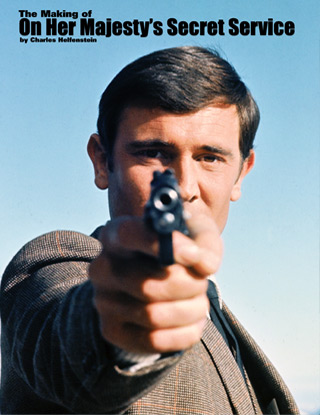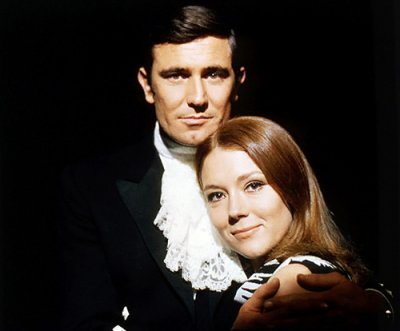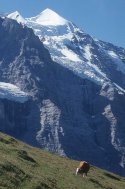|
The Making Of On Her Majesty's Secret Service

The Making of On Her Majesty's Secret Service was written by Charles
Helfenstein and first published in 2009. The book takes a
fascinating and comprehensive look back at what many fans believe to be
the greatest James Bond film ever made. On Her Majesty's Secret Service
was the first film in the series to be made without Sean Connery and he
was generally regarded to be irreplaceable. After an extensive casting
process though, it was decided that an unknown 29-year-old Australian
model called George Lazenby (with no acting experience save for a 'Big
Fry' chocolate advert) would be the new James Bond. The film did
reasonably well at the box-office but critics and audiences were, for
the most part, already missing Connery and grumbled accordingly. When
Lazenby declined an invitation to return in Diamonds are Forever (his
agent had told him Bond was finished and wouldn't last much longer!) he
quickly faded from view and both On Her Majesty's Secret Service and
his performance never seemed to get much credit.
Over time though the strengths of the film have become more and more
apparent. The spectacular Alpine locations, the supporting cast of
Diana Rigg and Telly Savalas, the fantastic action sequences, and the
decision to stick closely to Ian Fleming's original novel. Lazenby too
has been praised in retrospect for making Bond more human and
vulnerable while looking the part and throwing himself into the action.
The Making of On Her Majesty's Secret Service is a must for Bond fans
and draws on the archives of Ian Fleming, screenwriter Richard Maibaum
and director Peter Hunt. You get storyboards, interviews, marketing
material, art, hundreds of rare and often lavish behind-the-scenes
photographs of the cast and crew, the casting process, titbits about
life on the set and the rumours that Lazenby was difficult to work
with, and much, much more.
One of the most fascinating parts of the book for me was the insight
into the casting of the new Bond. Lazenby impressed everyone with his
look (the young Lazenby probably looks more like James Bond than any
other actor to play the role) and blagged a screentest by wearing
Connery style suits and acting like a playboy. He was up against John
Richardson, Hans de Vries, Robert Campbell and Anthony Rogers.
John Richardson, the star of One Million Years B.C, was close to
getting the role but Lazenby swung things in his favour when he
accidently broke the nose of stuntman/wrestler Yuri Borienko with a
stray punch during the fight scene part his audition. Lazenby was great
in fight sequences and director Peter Hunt was excited by the challenge
of taking a young, physical, inexperienced actor and turning him into
James Bond. For the pivotal role of Contessa Teresa di Vicenzo, Bond's
love interest and only wife, it was decided to cast an experienced and
capable actress to counter Lazenby's inexperience. Step forward Diana
Rigg, already an icon herself through The Avengers and eager at the
time the book tells us to do a big epic film.

The
famous story about Rigg disliking Lazenby so much she ate garlic before
love scenes is of course apocryphal the book tells us but there are
some interesting bits and pieces about Lazenby irritating the Bond
producers by acting like a star (Cubby Broccoli's view was that
audiences decide when someone is a star not actors) and also not
finding out that George Baker had dubbed him in the scenes where Bond
poses as geneologist Sir Hilary Bray to investigate Blofeld's Alpine
lair until he saw the finished film in the cinema! One thing the book
does an excellent job of is conveying the challenging nature of the
production. Peter Hunt had decided that the film would eschew gadgets
and present a more human Bond. It would also be more romantic than
other Bonds with Bond deciding to marry Rigg's Contessa Teresa in the
story. However, a location had to be found for 'Piz Gloria', Blofelds's
Alpine mountain base. The producers thought that Piz Gloria (described
as being like Hitler's 'Eagle's Nest') must have been based on a real
place by Fleming but couldn't find anything suitable. They finally
found the perfect Piz Gloria in a restaurant being built high on a
mountain near Interlaken.
A deal was struck for the Bond team to take over the site as long as
they built permanent interiors. However, they had to get 500 tons of
concrete to the location to build Blofeld's helicopter pad and the unit
spent 10 weeks in Switzerland in often challenging conditions. These
making of books can be rather bland (and I avoid many of them for this
reason) but this one is really great stuff and doesn't feel like a dry
authorised volume. The book begins with the original Fleming novel and
looks at how two or three attempts to adapt it for the screen were made
before it did finally occur, the most interesting thing here of course
being the changes and additions to each script. The 'legacy' of OHMSS
is great too and has details of Irma Brunt returning for Diamonds Are
Forever (though sadly it never happened) and stills of Pierce Brosnan
auditioning for Bond in 1986, acting a scene from On Her Majesty's
Secret Service. Among many revelations for Bond fans here is the news
that Bond's Scottish ancestry wasn't done by Fleming - as is widely
believed - for Sean Connery.
It goes without saying that a big part of the book's appeal lies with
the many and varied images, stills and pieces of art that grace the 290
pages. Many of these are amazing, especially some of the pictures of
Diana Rigg, who must surely have been one of the coolest women in
Britain around this time. There are many great stills of Lazenby too,
looking more like James Bond than Daniel Craig could ever dream of. The
Making of On Her Majesty's Secret Service is a superb and fascinating
book that any Bond fan worth his salt would be more than happy to get
hold of (hopefully you can get a good deal on it too). It's a great
glossy and information packed tribute to what is arguably the best Bond
film ever made.
- Jake
c
2010
Alternative 007
|

|


